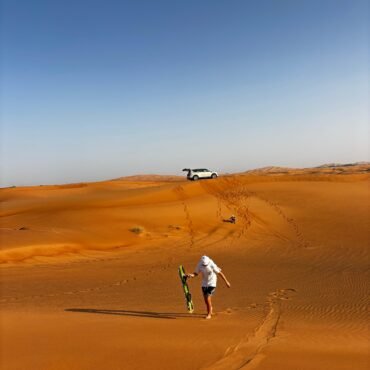The Arabian Desert is a place of contrasts, where the harsh sunlight of the day gives way to a world of subtle beauty as evening approaches. For those who have never experienced the desert at night, it is almost like stepping into another universe. The transformation is not only visual but sensory, emotional, and even spiritual. As the sun dips below the horizon, the desert reveals a side rarely seen by casual travelers—one that evokes wonder, calm, and adventure all at once.
The Magic of Sunset in the Desert
The desert’s transition begins long before darkness falls. As the sun nears the horizon, the golden sands glow with a warm, almost ethereal light. Dunes cast long shadows, creating a striking contrast that seems almost surreal. Photographers and artists are drawn to this moment for its unparalleled beauty, but anyone visiting at this time cannot help but be mesmerized by the changing landscape.
The heat of the day gradually recedes, and a gentle breeze often picks up, carrying the dry, clean scent of sand. For desert dwellers and tourists alike, sunset is a time for reflection—a pause between the blistering heat of the day and the crispness of the night. It is the perfect moment to sit atop a dune, watch the changing colors, and feel a sense of connection to the vast environment around you.
A Canvas of Stars
As darkness descends, the real transformation begins. Unlike cities where artificial lights obscure the night sky, the desert offers a clear, uninterrupted view of the stars. The Milky Way stretches across the horizon, and countless constellations are visible to the naked eye. This celestial display is not just beautiful—it is humbling. Standing under such a vast expanse of stars, visitors often find themselves contemplating life, nature, and the universe in ways that are difficult to replicate elsewhere.
The night sky is also an opportunity for education and storytelling. Local guides often share tales of constellations, desert lore, and ancient navigation methods. These stories add depth to the experience, blending natural beauty with cultural history. For many travelers, this combination of sights and stories becomes a highlight of their desert adventure.
The Sounds of the Night
Daytime in the desert is often defined by silence, broken only by the wind or the occasional call of wildlife. At night, this silence transforms into a rich tapestry of subtle sounds. The gentle rustling of sand, the distant cry of nocturnal animals, and the whisper of the wind through dunes create a unique soundscape. Unlike urban environments, the desert’s night sounds are unobtrusive, almost meditative.
These natural sounds can enhance the feeling of solitude and reflection. For some visitors, it is a chance to disconnect entirely from technology and the pressures of modern life. Simply listening to the desert at night can be as immersive and rewarding as any physical activity.
Cool Breezes and Comfortable Nights
Another noticeable change after sunset is the temperature. While daytime can be harsh and unrelenting, evening brings a welcome relief. Cool breezes sweep through the dunes, and the sands begin to lose the heat they absorbed during the day. Visitors often remark on how refreshing and comfortable the nights feel compared to the scorching afternoons.
This comfortable climate makes the desert an ideal location for nighttime activities. Many tour operators have developed experiences specifically designed for the evening and overnight hours, allowing travelers to enjoy the desert without the fatigue and heat associated with daytime adventures.
A Night of Adventure
As the darkness deepens, the desert offers opportunities for adventure that are simply not possible during the day. For thrill-seekers, activities like dune bashing, sandboarding, or camel rides take on a new dimension when performed under the stars or by moonlight. The shifting shadows of dunes, the cool air, and the unique atmosphere all contribute to a heightened sense of excitement.
For those seeking a more serene experience, there is the option to explore quiet desert trails, enjoy stargazing sessions, or participate in traditional cultural activities like henna painting, tea ceremonies, or storytelling around a campfire. These experiences allow visitors to connect with the local culture and environment in ways that are deeply memorable.
One of the most popular ways to fully immerse oneself in the desert night is through an Overnight Desert Safari. This experience allows travelers to spend several hours or even an entire night in the desert, enjoying activities, local cuisine, and a unique sense of tranquility that comes from being far away from urban distractions. Camping in the dunes under a sky filled with stars is not only an adventure but also a rare opportunity to experience the desert in its purest form.
Cultural Connection and Hospitality
Nighttime in the desert is also a time when visitors can engage with local Bedouin culture. Traditional desert camps often provide hospitality in the form of music, food, and storytelling. Guests can enjoy freshly prepared meals, sip on aromatic teas, and listen to traditional songs or drum performances. These experiences create a connection between visitors and the people who have called the desert home for centuries, providing insights into a way of life that is closely tied to the natural environment.
Such cultural immersion enhances the overall experience of the desert at night. It is not just about witnessing natural beauty but also about understanding the traditions and lifestyles that have developed in harmony with this unique landscape.
Reflection and Personal Transformation
For many travelers, the desert at night offers more than just physical beauty—it offers a chance for personal reflection. The quiet, vast landscape allows space to think, meditate, or simply be present. Whether sitting by a campfire, lying on the cool sands, or gazing at the stars, visitors often report a profound sense of peace and clarity.
This reflective aspect of the desert can be transformative. In a world that is constantly busy and noisy, spending a night under the open sky allows for a rare opportunity to slow down and reconnect with oneself. The desert’s stark contrasts between day and night mirror the internal contrasts in our own lives, offering lessons in patience, adaptation, and appreciation.
Preparing for a Desert Night
Experiencing the desert at night requires some preparation. Comfortable clothing suitable for cooler temperatures, sufficient hydration, and basic safety measures are essential. Those joining organized overnight tours can rely on experienced guides to ensure a safe and enjoyable experience, while solo travelers must take extra precautions.
Despite these considerations, the rewards of a desert night far outweigh the minor inconveniences. The sense of adventure, beauty, and connection is unparalleled, leaving travelers with memories that last a lifetime.
Conclusion
The Arabian Desert transforms completely when the sun goes down, offering experiences that are vastly different from the daytime. From the striking colors of sunset to the star-filled skies, from the cool breezes to the quiet sounds of nocturnal life, the desert at night is a place of wonder and reflection. Activities, cultural experiences, and personal introspection all combine to create a multidimensional adventure.
For those looking to experience the desert in its fullest form, an Overnight Desert Safari provides an unforgettable opportunity to witness this transformation firsthand. Spending a night among the dunes allows travelers to embrace the magic of the desert, connect with its culture, and experience a level of tranquility rarely found in other environments. The Arabian Desert at night is not just a destination—it is an experience, a journey, and a story waiting to be told.





